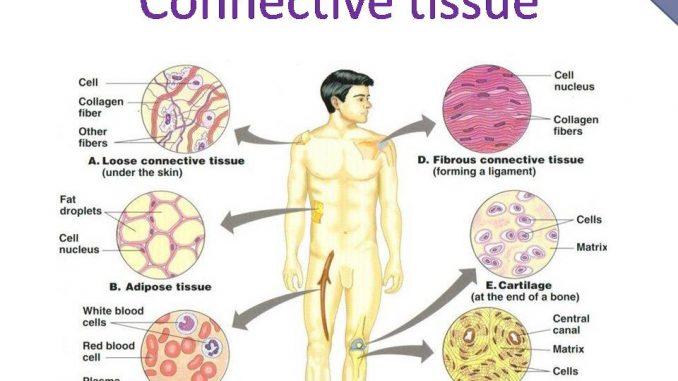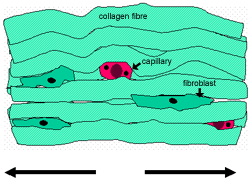Connective Tissue Types Diagram | These fibers form an irregular network with spaces. It develops from the mesoderm. Also, these tissues perform other function blood. In the knee and other joints, they absorb pressure from twisting, impact, and other. This type of epithelium typically consists of many layers of cells and is found where the mechanical stresses are severe.
Connects different parts of the body. Like all tissue types, it consists of cells surrounded by a compartment of fluid called the extracellular matrix (ecm). In the knee and other joints, they absorb pressure from twisting, impact, and other. Connective tissue, group of tissues that maintain the form of the body and its organs and provide cohesion and internal support. As may be obvious from its name, one of the major functions of connective tissue is to connect the three main types of cartilage tissue are hyaline cartilage, fibrocartilage, and elastic cartilage (figure.

Bone tissue is also called osseous tissue. Identify and list the cell types found in the various kinds of general connective tissues, and describe their origins and functions. Explain the functions of connective tissues. Connective tissue is classified based on the type of cells, arrangement and type of fibers, and composition of the extracellular matrix. It is also of two types: Connective tissue is made up of a small fraction of cells and a majority of extracellular substance which keeps the cells separated. Connective tissue is the most diverse and abundant tissue type. There are only four primary tissue types: Connective tissue is the tissue that connects, separates and supports all other types of tissues in the body. Tissue that connects your body's muscles, organs, blood vessels, nerves and other parts to one another. Connects different parts of the body. The two types of cells found in connective tissue. For now we will only concentrate on epithelial and connective tissues.
These fibers form an irregular network with spaces. Connective tissue, as the name suggests binds all the cells and organs of the body and provides protection and support to different body parts. Tissue that connects your body's muscles, organs, blood vessels, nerves and other parts to one another. Bone tissue is also called osseous tissue. White fibrous connective tissue and yellow.

Examples of connective tissue include adipose, cartilage, bone, tendons, and blood. Connective tissue is the most diverse and abundant tissue type. For now we will only concentrate on epithelial and connective tissues. There are only four primary tissue types: Functions include binding and supporting. Connective tissue is exactly what it sounds like: A connective tissue has two elements and these are the cell and the matrix. As may be obvious from its name, one of the major functions of connective tissue is to connect the three main types of cartilage tissue are hyaline cartilage, fibrocartilage, and elastic cartilage (figure. Gain expert knowledge on types of tissues! Connective tissue, as the name suggests binds all the cells and organs of the body and provides protection and support to different body parts. It develops from the mesoderm. Connective tissue, group of tissues that maintain the form of the body and its organs and provide cohesion and internal support. This is a grab bag category of diverse tissue types.
Explain the functions of connective tissues. Classification of connective tissue embryonic connective tissue. Bone tissue is also called osseous tissue. This type of epithelium typically consists of many layers of cells and is found where the mechanical stresses are severe. Connective tissue (development and structures).

Classification of connective tissue embryonic connective tissue. Distinguish the connective tissues from all epithelial tissues on the basis of location, cell density and the presence of discrete fibers. Connective tissue makes up a variety of physical structures including, tendons connective tissue has relatively few cells separated by a large amount of extracellular matrix (as opposed to epithelial tissue which exhibits high cellularity). The types of connective tissue include cartilage, bone, collagen fibers, reticular fibers, elastic fibers, blood, hemopoietic/lymphatic, adipose tissue, bone marrow, and lymphoid tissue. In the dense regular connective tissue, the collagen fibres are present in rows between many parallel bundles of fibres. Connective tissues are specialized tissues, which provide support and hold the body's tissues together. Tissue that connects your body's muscles, organs, blood vessels, nerves and other parts to one another. As may be obvious from its name, one of the major functions of connective tissue is to connect the three main types of cartilage tissue are hyaline cartilage, fibrocartilage, and elastic cartilage (figure. Connective tissue, group of tissues that maintain the form of the body and its organs and provide cohesion and internal support. In addition, they nourish and. Type location function xv tissues derived from mesenchyme , heart & skeletal muscle adhesion of basal lamina to the underlying connective tissue xvi broad tissue distribution fibroblasts& arterial. A connective tissue has two elements and these are the cell and the matrix. General biology | getting started | cells | genetics | classification | evolution | tissues & systems | additional material.
Identify and list the cell types found in the various kinds of general connective tissues, and describe their origins and functions connective tissue types. Loose connective tissue is named so because of the weave and type of its constituent fibers.
Connective Tissue Types Diagram: It form inter cellular substance between cells of different types of tissue, so that help in friction less movement of the body organ.
Source: Connective Tissue Types Diagram
No comments
Post a Comment